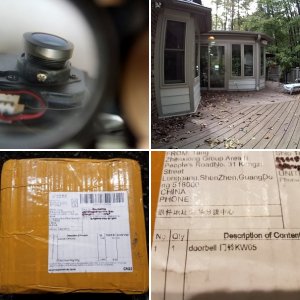Sorry to bump my own posts but wanted to provide some answers to a few questions I've presented in the last month or so. Disclaimer… I’m not running
BlueIris 
I just have a 8 Channel Lorex Security System kit. FYI: With all the computers I’ve built, my multiple networks, NAS etc, building a system with BlueIris would be a no brainer but my life is crazy busy right now. Found a Lorex system at Costco, new sealed box marked down multiple times as clearance item (last one) 8channel eight 4K cameras $499 I couldn’t pass it up. Installed no issues, so far all is good.
(snip)… It would be great to if the doorbell button that gets pressed is a mechanical button (e.g. spring loaded/buckling spring etc) or if its some sort of stationary, capacitive touch sensor (PCT) of some kind.
After receiving my SD-M5 (KW-05 manufacturer) I can confirm the button is a "mechanical" buckling spring button.
If the SD-M5 if cracked open would is it possible to solder leads directly to the pushbutton contacts. I'm hoping to use it with my existing mechanical doorbell .
Yes... if needed it is possible to isolate the push button contacts on the circuit board if your design requires it however, as it turns out hacking & soldering may not be necessary. Per Knox KW005 specs it states: Works with your 8~ 24V or 100~240V Existing Mechanical bell.
Unfortunately I have yet to find any specifics on how to accomplish that unless they mean via the USB chime kit which to me isn't the same as using my exisiting 1980's "mechanical" doorbell.
I'm able to monitor all the Lorex / Dahua cameras at my Lorex NVR... will I be able to monitor the SD-M5 at the NVR?
It's Onvif and offers an RTSP stream and it has been found to work with BlueIris and at least one other Onvif compatible program so chances are it will work with your NVR if that is Onvif too but the only way to be absolutely sure about compatibility is to try it out with your specific NVR.
My plan is to hook this doorbell camera to my Lorex LNR6100 NVR via
CAT5e/6 and a Ubiquiti PoE Adapter and just let it record 24/7 like the other cameras in the system. Will a CAT5e/6 POE connection to the doorbell alone carry video back to the NVR or is the ENET port on the doorbell only for power to the camera? (just want to verify WIFI is not required for video)
ANSWER: Yes! As it turns out, the only connection made to the doorbell was the Ethernet cable. It powers the camera as well as carry video feed back to my NVR. I'm currently able to monitor and record all my Lorex / Dahua cameras at the NVR as well as the SD-M5.
NOTE: Thanks to feedback from
@SecuritySeeker, the Ubiquiti INS-3AF-I-G adapter
was indeed needed in my specific application because the doorbell is passive and was not 802.3af/802.3at as required by the Lorex NVR.
Initial Observations:
Upon initial connection/power up of doorbell the tamper alarm activates and sounds off for about 5 seconds or so.
Pressing the doorbell button the doorbell assembly itself emits an audible doorbell tone which gives the visitor an indication that the doorbell works and homeowner has been alerted.
Unfortunately I haven't discovered how or if I can get the Lorex NVR to detect the doorbells motion sensor feature as it currently does with the motion sensors in the Lorex cameras. Also... although my particular Lorex NVR allows for two way audio and recording... at this time I can only get the feature to work using their cameras. Beginning to think those particular features won't work due to firmware variations.
… purchased via ebay. Seller accepted my $60 “offer” for the standalone doorbell with Free shipping. BTW...great communication from my specific seller... has sent me several messages both pre and post order .. including a tracking number with an estimated arrival in October (about 20 days but I'm not holding my breath... I won't believe it until I see it.) Will follow up once the shipment arrives.
193052391626 | eBay
Actually took 30 days ... door to door. @
johnnyletrois who also ordered via bay received his in 16 days door to door! Tracking shows both shipments were shipped within 2 days of the orders being placed. Even though he’s on the west coast and I’m on the east coast, both were shipped via China EMS e-packet so I can’t account for why mine took almost twice as long to arrive.
... all China sellers currently advertising them on ebay, show an estimated "delivery date" which slips a little each day, now stating:
This item has an extended handling time and a delivery estimate greater than 19 business days. Fri. Nov 8 and Fri. Dec. 23
Side note
As far as I could tell from my research it appears the YouSee MD-S5 might actually be a product of: Shenzhen Konx Smart Technology Co. Ltd:
Products- - KONX International Limited. In any event, for those interested I uploaded some photos to the Media section of ipcamtalk… showing the unboxing and contents of my ebay purchase as well as an image capture taken with the doorbell (ignore the time stamp

) . Was surprised to find the doorbell included a 12 page full color user manual printed entirely in English!

ipcamtalk.com


 Much appreciated.
Much appreciated. ) . Was surprised to find the doorbell included a 12 page full color user manual printed entirely in English!
) . Was surprised to find the doorbell included a 12 page full color user manual printed entirely in English!
